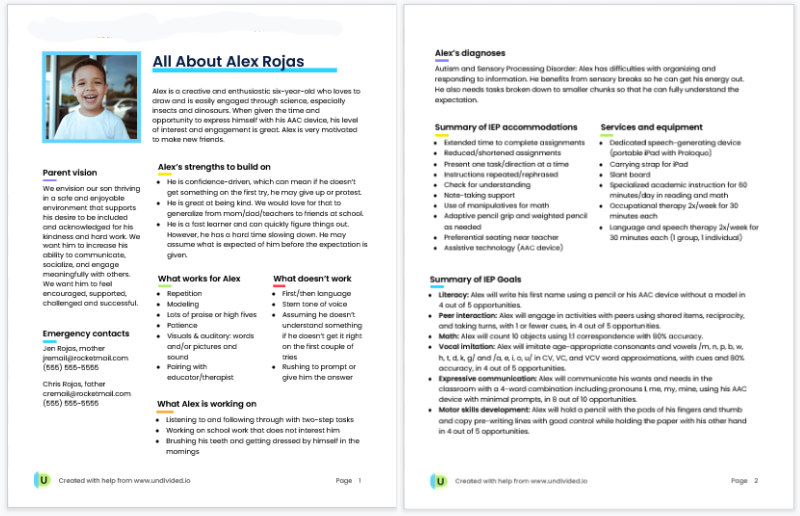School’s Back! 5 Essentials for the First Week
Special education advocate Dr. Sarah Pelangka, BCBA-D and owner of KnowIEPs, sat down with us to talk about essentials that parents should be aware of — and make a plan to tackle — as we send our kids back to school!
Here are Dr. Pelangka's top three tips for parents to help kids transition into a new school year:
1. Check in with your child’s teacher about their accommodations
Your child’s “All About Me” is great for introducing your child’s most important IEP accommodations to a new teacher on the first day of class, but it’s important to ensure that your child is actually getting access to those accommodations from the start. If your child needs seating near the front of class, adaptive supplies, visual aids, sensory breaks, or other accommodations to get them back into the routine of school, check in with the teacher about making sure your child is being set up for success in their classroom.
Dr. Pelangka recommends two ways to follow up on accommodations: observe your child in class (either yourself or by sending someone in your place) or give the teacher permission to record video of your child using the accommodation.
Depending on your child’s age, check in with them about their accommodations too! Dr. Pelangka says, “I think it's really helpful as early as possible for students to be mindful and aware of what their accommodations are and what their services are, so in the event those things aren't happening, they can learn to self-advocate, and they can speak up and say, ‘Hey, I was supposed to get extra time for that test,’ or ‘I was supposed to have my notes and I didn't get to use them,’ or whatever the case may be, they can also go home and tell you, ‘Hey, I didn't get X, Y, and Z,’ and you'll be aware of that. This isn't saying that the child is responsible for requesting those accommodations if that's not how the IEP is written — it's just helping them learn those and work on starting that self-advocacy process.” You could print a list of your child’s accommodations to include in their binder or tape a couple pictures to their desk as a reminder.
2. Be aware of staff shortages
As many of us know, there are staff shortages across many industries these days, and unfortunately one of those is in school districts.
Dr. Pelangka explains that school staff shortages may mean a shift in the way that special education classes and related services will be offered. This could include everything from co-taught classes to virtual related services (such as speech therapy). It’s important to remember that while we all need to work together to do what’s best for our kids, parents do not have to agree to classroom placements or service delivery models that don’t work for our kids. Here’s how to push back:
3. Advocate for inclusion
4. Prepare for assessment plans
Dr. Pelangka recommends asking your district to wait about thirty days into the new school year, depending on how quickly your child is able to adapt, before offering an assessment plan. Many students struggle with changes in routine, and your child may need time to acclimate to their new classroom, services, and school environment. A thorough assessment is the first step to creating an IEP that accurately reflects your child's goals, strengths, and areas of need, so waiting until students are comfortable can go a long way toward making that happen.
“Give them some time to acclimate,” Dr. Pelangka says, especially if the school is considering a change in placement. She advises parents to ask the district about all other options for changing placement: “Have we considered a one-to-one aide or a classroom aide or an extra parent in the room? Have we looked at if there's behavioral needs, like introducing a behavior plan? Have we looked at accommodations?”
5. Reach out to your IEP team to request a one-month check-in
When your child is starting out the school year, whether it’s at a new school or with a new teacher, it’s a good idea to set a check-in meeting four to six weeks after school begins. Here’s a refresher on how to request an IEP meeting.
While you may have specific things in their IEP to discuss, the main reason it’s important to hold this meeting is to start building trust and relationships with a new IEP team. Dr. Pelangka explains why in this clip:
Be sure to check out our free back-to-school toolkit for templates, checklists, an All About Me printable, and more resources to help you prepare!
Need more help with getting your child the school supports they need throughout the year? Undivided's digital workspace has everything you need, from step-by-step guides to 1:1 coaching, Q&As with Education Advocates, and more. Learn more about how Undivided helps with back to school →
Join for free
Save your favorite resources and access a custom Roadmap.
Get StartedAuthor



